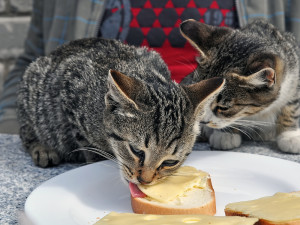7 Surprising Flavors Cats Love
And whether they should have them, according to a nutritionist.

Share Article
Does your cat eat off your plate? Do they sneak popcorn from your bowl when you’re not looking or suddenly appear at your feet every time you take cheese out of the fridge? It’s sort of charming, right? And it makes you feel closer to them when you see them enjoying your favorite foods. But are they good for them? Cats are obligate carnivores, which means they have to eat meat to survive and generally do not digest plant material well. But they are capable of enjoying a wide range of foods, whether they are good for them or not.
According to Reddit users,opens in new tab cats can be fans of everything from olives and cheese to hot wings and melon. But just because a cat likes eating something doesn’t mean they should. So, we reached out to Dr. Neus Torrent Ampleopens in new tab, a veterinarian and certified pet nutritionist at Outdoor Bengalopens in new tab, to find out why cats love these surprising flavors and whether we, as responsible cat parents, should be including them in their diets.
1. Olives
“My cat goes crazy for olives,” a Reddit user says. “It’s like a drug or something. He reacts to them like catnip.”
Green olives, in particular, contain a chemical called oleuropein, “which is similar to nepetalactone, the active ingredient in catnip,” Dr. Ample says. “So, the oleuropein in olives can stimulate a similar, though typically milder, response.”

The problem with olives is that they are often high in sodium, which is bad for cats and can lead to salt poisoning in large enough quantities. That said, if you can manage to find green olives with no sodium, Dr. Ample says it’s fine for cats to have up to eight grams per day (or one to two olives).
2. Mild cheeses and butter
“[Our cat] Mocha loved butter,” a Reddit user says. “We did not allow her to eat butter. But she’d appear right behind you while you were eating toast, wait for you to set it down, and lick the butter when she thought you weren’t looking. Usually too quickly for you to stop her. My dad called her the butter-faced bandit.”
“You really can’t turn your head for a second,” another user writes. “My daughter was making something with shredded cheese. She turned her back for a second, and the cat grabbed the bag. It was easy to find her because she left a trail of orange cheese from the kitchen, down the hallway, and into the bedroom.”
“Both cheese and butter are high in fats, which cats find very appealing,” Dr. Ample says. “As obligate carnivores, their diet primarily consists of meat, which is naturally high in fat and protein and the fatty, rich texture of butter and cheese mimics the consistency and flavor profile of animal fat, making it irresistible to some cats.” Cheese also contains proteins and amino acids like casein and whey, which cats find tasty for the same reason.
Most cats are lactose intolerant, so it is possible that dairy of any kind could upset their stomachs, but if your cat can handle it, Dr. Ample says it’s fine to give them some from time to time, as long as you don’t exceed four grams per day.
3. Salty snacks: popcorn, potato chips, and Cheetos
“My [cat], Kali, is obsessed with popcorn,” one Reddit user says. “When I have a bowl, it’s one kernel for me, one for her, and so on. If she thinks I’m not sharing evenly enough, she will try and stick her paw in the bowl and get some for herself!”
“[My cat] absolutely loves hot Cheetos and Cheeto puffs,” another writes.
“Cats have a strong preference for umami, which is why they’re drawn to foods high in meaty or savory flavors,” Dr. Ample says. “Processed snacks often contain ingredients like monosodium glutamate (MSG) or yeast extract, which provide that umami boost. Although cats are obligate carnivores, the savory flavors in these foods can trick them into thinking they’re close to a meaty snack.”
Salt is bad for cats, though — especially in the quantities found in human snack foods — so Dr. Ample suggests keeping them out of your pet’s diet.
4. Hot wings
One Redditor writes about having to hold their cat back to stop them from tearing into a box of hot wings, while another says their cat loves all spicy foods. “And those Mango popsicles rolled in tajin [— she] goes nuts when we eat those,” the user writes.
While most cats don’t enjoy spice, clearly there are those that do. Unfortunately, many spicy foods often contain high amounts of salt and other ingredients that are toxic to cats such as onions, garlic, black pepper, and curry. So if your cat is one of the rare ones who likes the tingly mouth feel of spice, make sure to check the ingredients before indulging them.
5. Spinach, broccoli, and other leafy greens
A Reddit user writes that her cat is “absolutely crazy for spinach,” while many others mention their cats’ love of broccoli and salad greens.
“It’s not clear why some cats love them,” Dr. Ample says. “But broccoli and spinach contain trace vitamins, like A, C, and K, and minerals, like iron and calcium, that complement a cat’s diet.”
For people making their own cat food, Dr. Ample suggests no more than 40 grams of spinach or 35 grams of broccoli per day, since, even if your cat loves veggies, their diet should still be primarily meat.
6. Melons
“My cat will stop at nothing to get to cantaloupe,” a Reddit user writes.
“Once, I left a cantaloupe out on the counter, and she chewed through the rind and ate a baseball-size portion of the melon,” writes another.
“Melons, especially cantaloupe, contain amino acids that have a scent profile somewhat similar to proteins found in meat,” says Dr. Ample. “Cats have a heightened sense of smell, and this slight similarity might make melons seem like an intriguing food source.”
If your cat loves melon, Dr. Ample says it’s fine to incorporate it into their diets but only occasionally and never more than 15 grams per day.
7. Gummy candies
“[My cat loves] Gummi Bears. Weirdest thing I’ve ever seen,” one user says.
“Mine likes gummies, too,” writes another. “Especially sour [gummy] worms.”
Cats are not able to taste sweetness, but many gummy candies are made with gelatin, which is an animal by-product. “Cats are naturally attracted to animal-derived proteins,” Dr. Ample says. ”So, the slight scent or taste of gelatin might appeal to them on a primal level.”
Even so, sugar is not good for your cat: They do not digest it well and, like in humans, it can lead to weight gain and related health issues. What’s more, many gummies contain artificial sweeteners like xylitol, which is toxic to cats.
Other toxic ingredients for cats include: alcohol, grapes and raisins, chocolate, macadamia nuts, and mint. Of course, that doesn’t stop some cats from seeking these flavors out. “I had a cat who would climb into my face for the extra-strength HALLS,” a Reddit user writes. “He was obsessed with menthol. I had Vicks Kleenex once, and he would pull them out of the box and lick them. I came home from work one day and found damp Kleenex all over the couch.”
Mint can cause liver damage, intestinal distress, vomiting, and diarrhea, but cats don’t know that. All they know is what they like, so it’s up to you to make sure they don’t have access to anything that could be dangerous. If you have any questions about the safety of your cat’s particular food preferences, ask your veterinarian.

Charles Manning
Charles Manning is an actor and writer based in New York City. In his free time he likes to cook, go swimming at the public pool, volunteer at the LGBTQ senior center, and foster senior and special-needs cats. His work has previously appeared in Cosmopolitan, Elle, Marie Claire, Harper’s Bazaar, Seventeen, and Nylon.
Related articles
![Two grey cats eating swiss cheese off of slices of bread while sitting on a table]()
You Should Not Invite Your Cat to Your Fancy Cheese Party
Save the charcuterie for the humans.
Can Cats Eat Popcorn?
They want to enjoy movie night, too, you know.
![Cat behind a curtain attempting to get fruit in blue bowl]()
What Fruits and Veggies Can Your Cat Feast On?
Pass the fruit bowl — it’s treat time.
![White kitten with tongue out next to slices of watermelon]()
Can Cats Eat Watermelon and Watermelon Rind?
Yes, watermelon is a nutritious treat for cats.
![Cat asking for human food from counter]()
What Can Cats Eat Besides Cat Food?
Good news for your begging cat: Some of your favorite snacks are safe to share.
![Grey cat eats a strawberry]()
Can Cats Eat Strawberries
Yes, strawberries are a nutritious treat for dogs.








